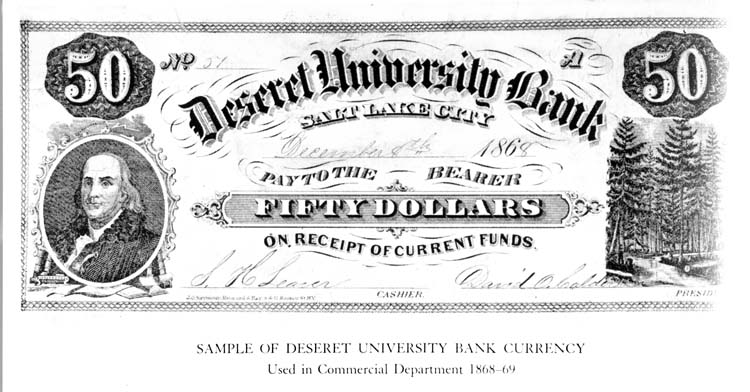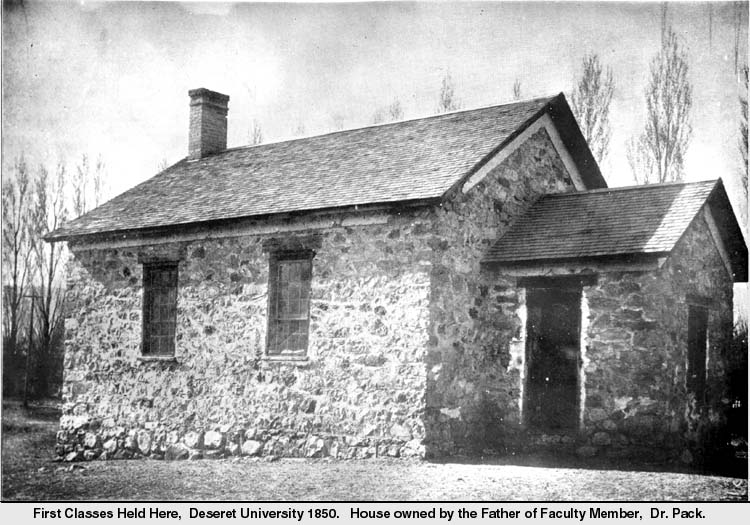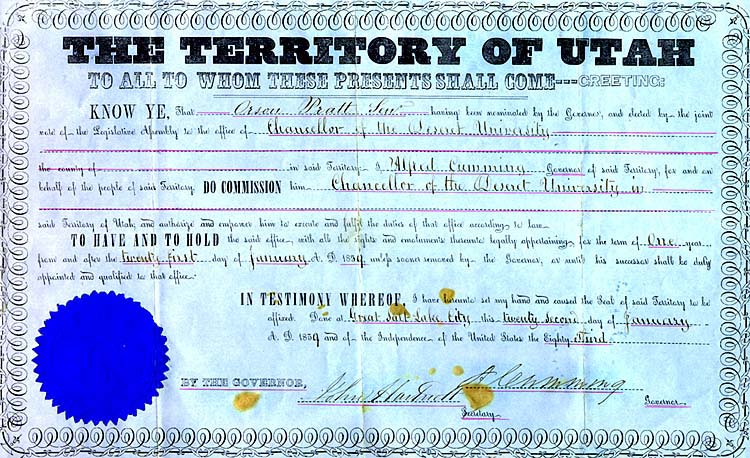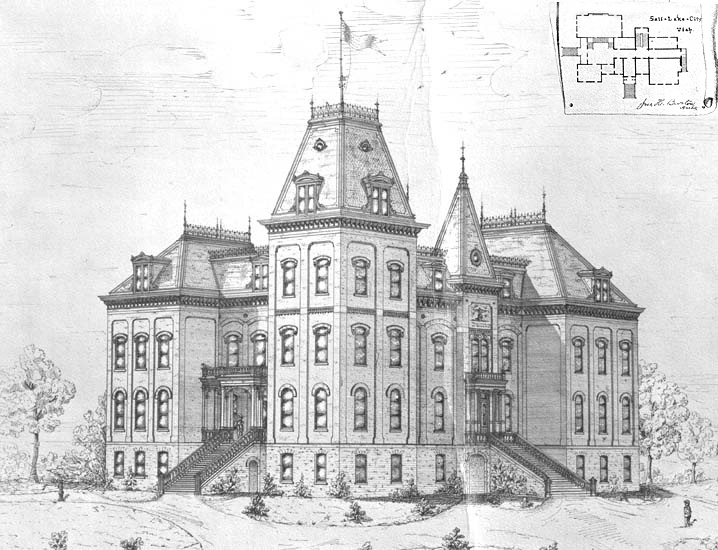801-585-3073
University of Utah Sesquicentennial, 1850 - 2000
Deseret University, 1850-1892

The Beginning of Higher Education in Utah
Within a few short years of their arrival in the Salt Lake valley in 1847, the Mormon pioneers took the first halting steps toward establishing a university. The University of Deseret, as it was to be called, was created by an act of the General Assembly of the State of Deseret on February 28, 1850. Orson Spencer, a leader of the L.D.S. church, was appointed Chancellor. Basics such as books, teachers, and even a place to hold classes were in short supply, due to hard economic times, including crop failures and increasing federal pressure on the L.D.S church to abandon polygamy. The first classes were held in private homes, or wherever suitable space could be found. Funds to pay teachers and for supplies came from private donations. But it was not enough, and in 1853, the budding University was forced to suspend operations. For the next decade and more, classes were still held on an intermittent basis in the Council House. The urge for an institution of higher learning in Utah was strong, but the economic foundation was just not solid enough.
Early Growth & Stability
By 1869, however, conditions in Utah had changed. Relations with the federal government had improved--if only slightly, and would soon worsen yet again--the economy had progressed beyond bare survival, the transcontinental railroad was just completed, and once again leaders of the state began to plan for a University on a permanent basis. The University of Utah got its first major boost that year when the Regents hired a well-known educator, John R. Park, to be Principal and later President.
Under President Park, the University of Deseret finally began to send down solid roots in the community, and would never again be forced to close. Park spent 1871 through 1872 touring universities in Europe, studying their organization and curriculum.
In 1876, the school moved out of the Council House and into the Union Academy, an adobe building located at 200 West 400 North in Salt Lake City. A few years later, the Territorial Legislature appropriated funds to purchase a site and erect a building to house the growing University. The Regents obtained Union Square from the city of Salt Lake, and in 1884 moved into the first building that it could call its own. In 1886, the University granted its first degrees, and the Alumni Association was organized. The Utah Territorial Library was transferred to the University of Deseret in 1890, and a chair of Geology and Mineralogy, the predecessor of the School of Mines, was established. Students were offered a Classical course of four years; a Scientific course of three years, and a Normal course of two years.
Early Community & Legacy
Student life began to develop; there were literary and debating societies established during this period; several attempts at a literary magazine, and the tradition of an annual University Ball was established.
Noted faculty during this early, formative period, included (besides Dr. Park, who was “much beloved”) Joseph B. Toronto; Francis Marion Bishop; Joseph T. Kingsbury; Karl G. Maeser; and the misses Cook, Mary and Ida. Even under trying conditions of economy and uncertainty about location, the University produced a number of graduates who would be heard of in many fields in the years to come.
They included Heber M. Wells, a governor of Utah; Rudger Clawson, a General Authority of the L.D.S. church; Heber J. Grant, president of the L.D.S. church; Don Carlos Young, a famous architect; Richard W. Young, who would rise to the rank of General in the U.S. Army; B. H. Roberts, the famous historian; and Orson F. Whitney, a Mormon scholar and historian.
Major changes took place in 1892. On February 17, the Territorial Legislature changed the name to the University of Utah. John R. Park, in declining health, resigned as President; but before he did, he realized that the Union Square location was inadequate for a major university, and planned to relocate the University on the east bench of the Salt Lake valley. With that in mind, he began negotiations with the US Army to obtain land at Fort Douglas, and the Territorial Legislature petitioned the U.S. Congress for a grant of land for a new campus. The stage was now set for the move to the east bench of Salt Lake City, a move that would portend much for the future of the University of Utah.








